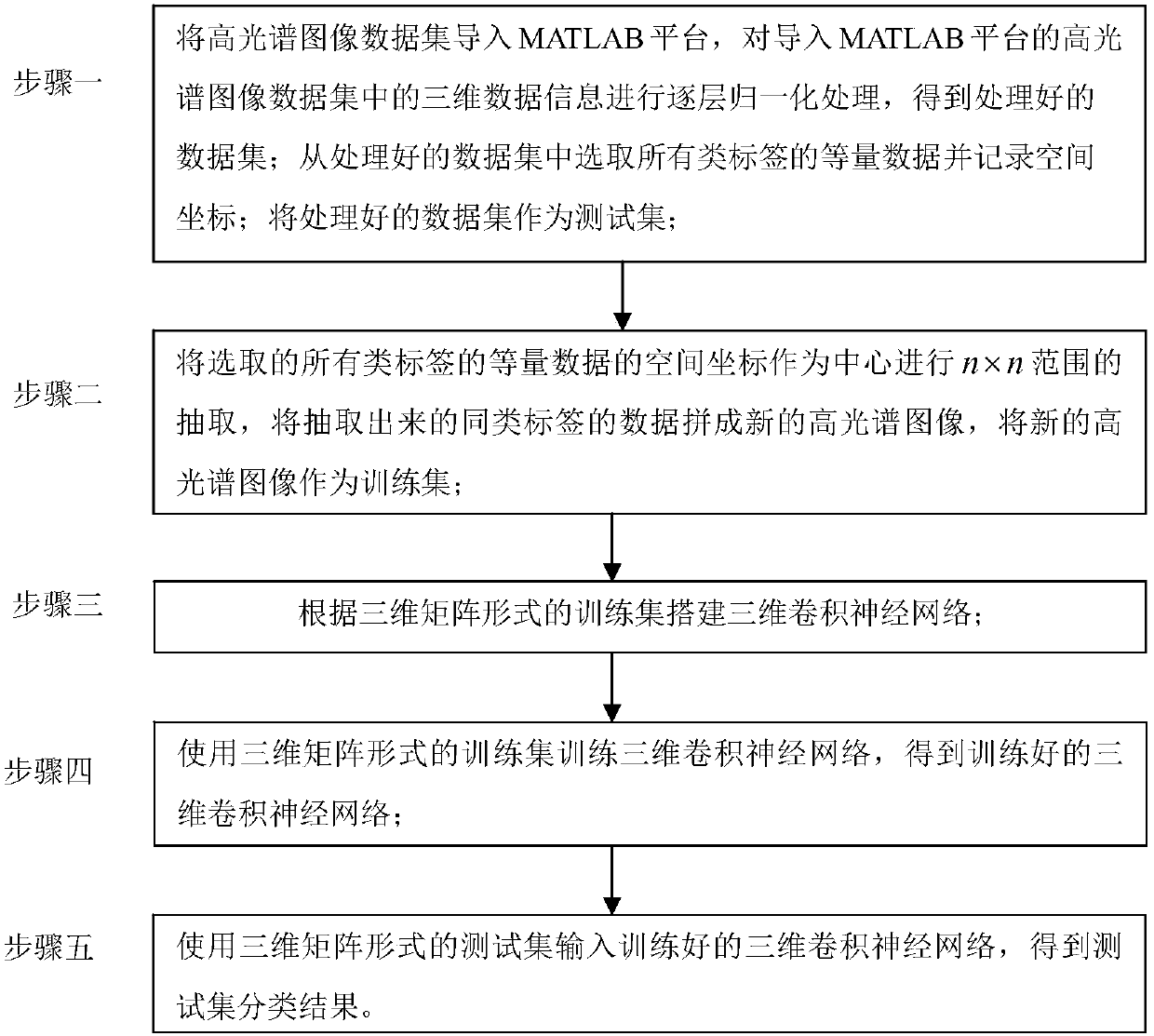Hyperspectral image classification method based on three-dimensional convolutional neural network
A hyperspectral image and three-dimensional convolution technology, applied in the field of hyperspectral image classification, can solve the problems of destroying the spatial information and spectral information of three-dimensional hyperspectral images, rearranging rough three-dimensional signals, and being unable to fully utilize the spatial information of hyperspectral images, etc. Achieving a good classification effect
- Summary
- Abstract
- Description
- Claims
- Application Information
AI Technical Summary
Problems solved by technology
Method used
Image
Examples
specific Embodiment approach 1
[0029] Specific implementation mode one: combine figure 1 To illustrate this embodiment, the specific process of the three-dimensional convolutional neural network-based hyperspectral image classification method in this embodiment is as follows:
[0030] Step 1, importing the hyperspectral image data set into the MATLAB platform, performing layer-by-layer normalization processing on the three-dimensional data information in the hyperspectral image data set imported into the MATLAB platform, to obtain a processed data set;
[0031] Select the equivalent data of all class (soil, water and sky) labels from the processed data set (200 for soil, 200 for water and 200 for sky) and record the spatial coordinates;
[0032] Use the processed data set as a test set;
[0033] The three-dimensional data information in the hyperspectral image data set includes spectral information and spatial information;
[0034] The hyperspectral image data set is in the form of a three-dimensional mat...
specific Embodiment approach 2
[0044] Specific embodiment two: the difference between this embodiment and specific embodiment one is: in the step one, the hyperspectral image data set is imported into the MATLAB platform, and the three-dimensional data information in the hyperspectral image data set imported into the MATLAB platform is classified layer by layer After one-time processing, the processed data set is obtained; the specific process is as follows:
[0045] Import the hyperspectral image data set into the MATLAB platform used in the experiment, and normalize the three-dimensional data information of the hyperspectral image data set imported into the MATLAB platform layer by layer. The formula is:
[0046]
[0047] In the formula, 1≤i≤W, 1≤j≤L, 1≤k≤H, is the normalization function, is the three-dimensional data of the hyperspectral image data set at positions i, j, and k, i, j represent the spatial position of the three-dimensional data information in the hyperspectral image data set, k repre...
specific Embodiment approach 3
[0051]Specific embodiment three: what this embodiment is different from specific embodiment one or two is: in described step 3, build three-dimensional convolutional neural network according to the training set of three-dimensional matrix form in described step three; Concrete process is:
[0052] 1) The three-dimensional convolutional layer performs sliding window convolution on the training set in the form of a three-dimensional matrix as the input of the three-dimensional convolutional neural network, and uses the three-dimensional convolutional layer as the first layer of the three-dimensional convolutional neural network;
[0053] When using a three-dimensional convolutional layer as the first layer of a three-dimensional convolutional neural network, the input_shape (when the training set in the form of a three-dimensional matrix is used as input) parameter must be provided;
[0054] 2) The channel position of the training set data after sliding window convolution is sp...
PUM
 Login to View More
Login to View More Abstract
Description
Claims
Application Information
 Login to View More
Login to View More - R&D
- Intellectual Property
- Life Sciences
- Materials
- Tech Scout
- Unparalleled Data Quality
- Higher Quality Content
- 60% Fewer Hallucinations
Browse by: Latest US Patents, China's latest patents, Technical Efficacy Thesaurus, Application Domain, Technology Topic, Popular Technical Reports.
© 2025 PatSnap. All rights reserved.Legal|Privacy policy|Modern Slavery Act Transparency Statement|Sitemap|About US| Contact US: help@patsnap.com



